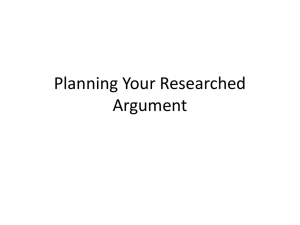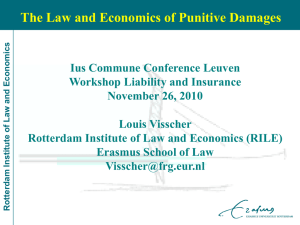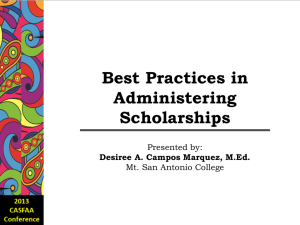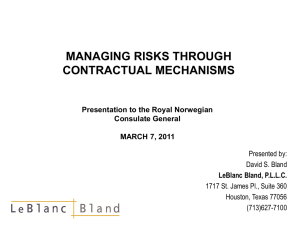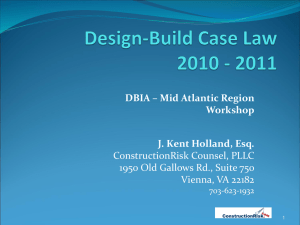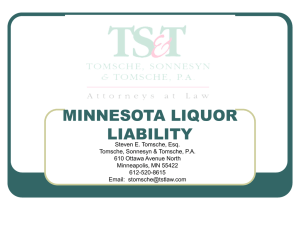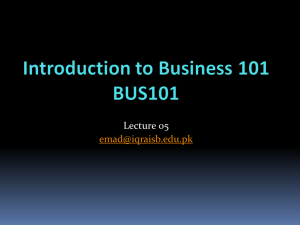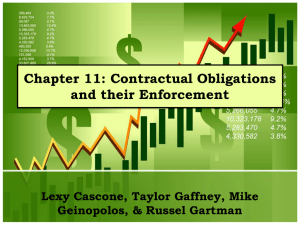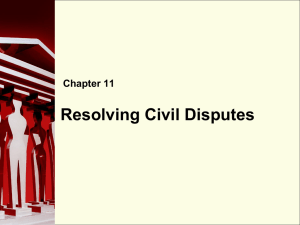Lecture 19
advertisement
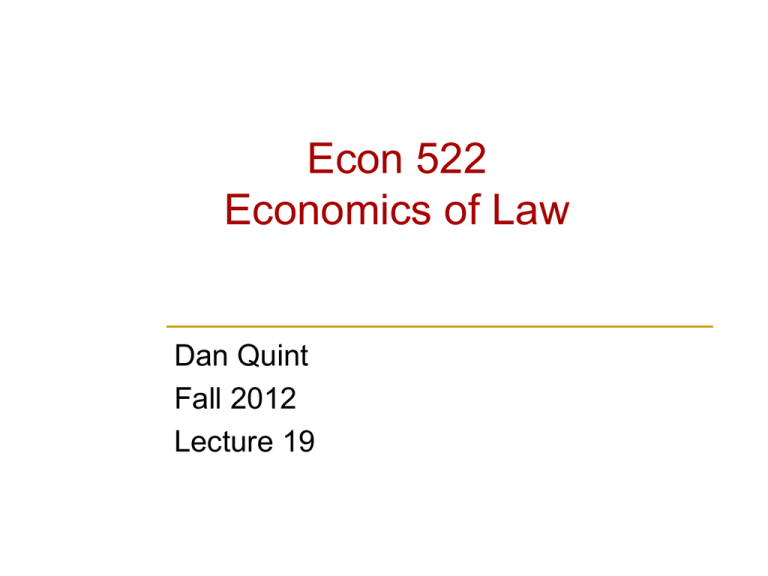
Econ 522 Economics of Law Dan Quint Fall 2012 Lecture 19 Outline of the next few weeks Remaining lectures Today: wrap up tort law Wednesday: the legal system in general Next week (Dec 3 and 5): criminal law Mon Dec 10: behavioral economics and the law Wed Dec 12: return to efficiency, wrap-up Remaining logistics HW4 will be up online today, due Thursday Dec 6 Midterm 2 will (hopefully) be returned Wednesday Final exam Wed Dec 19, 12:25 p.m., Soc Sci 6210 1 Jumping back into tort law Coase Theorem relied on voluntary negotiations to allocate goods, and rights, efficiently Certain interactions, ex-ante negotiations not feasible I can’t negotiate with everyone in Madison over how carefully I should drive Best we can do: design rules that make “good” behavior in my own private interest Several ways we could discourage adverse behavior “Punish the behavior” – criminal law, speed limits, safety regulation “Punish the outcome” – strict liability rule “Punish the combination of behavior and outcome” – negligence rule 2 Jumping back into tort law “I hear in some places, you need one form of ID to buy a gun, but two to pay for it by check. It’s interesting who has what incentives to care about what mistakes.” - XKCD 3 Jumping back into tort law We’ve focused on a few particular incentives: Injurer precaution Victim precaution Injurer activity level Victim activity level …and considered what would happen under a rule of… No liability Strict liability Various versions of a negligence rule Both in interactions between private individuals… …and between businesses and individuals 4 Jumping back into tort law Also examined how legal standard for negligence is set Hand Rule: efficient precautions are required Other ways: safety standards, industry norms …and the effect of errors in implementing each rule Strict liability rule: random errors in calculating damages have no effect, systematic errors do Negligence rule: small errors in damages have no effect; errors in standard for negligence have strong effect; uncertainty in legal standard leads to overprecaution …and the effects of other “complications” Irrationality; judgment-proofness; regulation; insurance; costly litigation 5 Experiment 6 My favorite problem from an old exam 7 More twists on liability 8 Vicarious Liability Vicarious liability is when one person is held liable for harm caused by another Parents may be liable for harm caused by their child Employer may be liable for harm caused by employee Respondeat superior – “let the master answer” Employer is liable for torts of employee if employee was acting within the scope of his employment 9 Vicarious Liability Gives employers incentive to... be more careful who they hire be more careful what they assign employees to do supervise employees more carefully Employers may be better able to make these decisions than employees… …and employees may be judgment-proof 10 Vicarious Liability Vicarious liability can be implemented through… Strict liability rule: employer liable for any harm caused by employee (as long as employee was acting within scope of employment) Negligence rule: employer is only liable if he was negligent in supervising employee Which is better? It depends. If proving negligent supervision is too hard, strict vicarious liability might work better But an example favoring negligent vicarious liability… 11 Joint and Several Liability Suppose you were harmed by accident caused by two injurers Joint liability: you can sue them both together Several liability: you can sue each one separately Several liability with contribution: each is only liable for his share of damage Joint and several liability: you can sue either one for the full amount of the harm Joint and several liability with contribution: the one you sued could then sue his friend to get back half his money 12 Joint and Several Liability Joint and several liability holds under common law when… Defendants acted together to cause the harm, or… Harm was indivisible (impossible to tell who was at fault) Good for the victim, because… No need to prove exactly who caused harm Greater chance of collecting full level of damages Instead of suing person most responsible, could sue person most likely to be able to pay 13 Punitive damages 14 Inconsistency of damages Damage awards vary greatly across countries, even across individual cases We saw last week: As long as damages are correct on average, random inconsistency doesn’t affect incentives (under either strict liability or negligence) But, if appropriate level of damages isn’t well-established, more incentive to spend more fighting 15 One problem with inconsistent damages: more incentive to fight hard Example: each side can hire cheap lawyer or expensive lawyer Cheap lawyer costs $10, expensive lawyer costs $45 If two lawyers are equally good, expected judgment is $100 If one is better, expected judgment is doubled or halved Plaintiff Defendant Cheap Lawyer Expensive Lawyer Cheap Expensive 90, -110 40, -95 155, -210 55, -145 16 Punitive damages What we’ve discussed so far: compensatory damages Meant to “make victim whole”/compensate for actual damage done In addition, courts sometimes award punitive damages Additional damages meant to punish injurer Create stronger incentive to avoid initial harm Punitive damages generally not awarded for innocent mistakes, but may be used when injurer’s behavior was “malicious, oppressive, gross, willful and wanton, or fraudulent” 17 Punitive damages Calculation of punitive damages even less well-defined than compensatory damages Level of punitive damages supposed to bear “reasonable relationship” to level of compensatory damages Not clear exactly what this means U.S. Supreme Court: punitive damages more than ten times compensatory damages will attract “close scrutiny,” but not explicitly ruled out 18 Example of punitive damages: Liebeck v McDonalds (1994) (“the coffee cup case”) Stella Liebeck was badly burned when she spilled a cup of McDonalds coffee in her lap Awarded $160,000 in compensatory damages, plus $2.9 million in punitive damages Case became “poster child” for excessive damages, but… 19 Liebeck v McDonalds (1994) Stella Liebeck dumped coffee in her lap while adding cream/sugar Third degree burns, 8 days in hospital, skin grafts, 2 years treatment Initially sued for $20,000, mostly for medical costs McDonalds offered to settle for $800 McDonalds serves coffee at 180-190 degrees At 180 degrees, coffee can cause a third-degree burn requiring skin grafts in 12-15 seconds Lower temperature would increase length of exposure necessary McDonalds had received 700 prior complaints of burns, and had settled with some of the victims Quality control manager testified that 700 complaints, given how many cups of coffee McDonalds serves, was not sufficient for McDonalds to reexamine practices 20 Liebeck v McDonalds (1994) Rule in place was comparative negligence Jury found both parties negligent, McDonalds 80% responsible Calculated compensatory damages of $200,000 times 80% gives $160,000 Added $2.9 million in punitive damages Judge reduced punitive damages to 3X compensatory, making total damages $640,000 During appeal, parties settled out of court for some smaller amount Jury seemed to be using punitive damages to punish McDonalds for being arrogant and uncaring 21 What is the economic purpose of punitive damages? We’ve said all along: with perfect compensation, incentives for injurer are set correctly. So why punitive damages? Example… Suppose manufacturer can eliminate 10 accidents a year, each causing $1,000 in damages, for $9,000 Clearly efficient If every accident victim would sue and win, company has incentive to take this precaution But if some won’t, then not enough incentive Suppose only half the victims will bring successful lawsuits Compensatory damages would be $5,000; company is better off paying that then taking efficient precaution One way to fix this: award higher damages in the cases that are brought 22 This suggests… Punitive damages should be related to compensatory damages, but higher the more likely injurer is to “get away with it” If 50% of accidents will lead to successful lawsuits, total damages should be 2 X harm Which requires punitive damages = compensatory damages If 10% of accidents lead to awards, damages should be 10 X harm So punitive damages should be 9 X compensatory damages Seems most appropriate when injurer’s actions were deliberately fraudulent, since may have been based on costbenefit analysis of chance of being caught 23 Some empirical observations about tort system in the U.S. (might not get to) Skip 24 U.S. tort system In 1990s, tort cases passed contract cases as most common form of lawsuit Most handled at state level: in 1994, 41,000 tort cases resolved in federal courts, 378,000 in state courts in largest 75 counties Most involve a single plaintiff (many contract cases involve multiple plaintiffs) Among tort cases in 75 largest U.S. counties… 60% were auto accidents 17% were “premises liability” (slip-and-fall in restaurants, businesses, government offices, etc.) 5% were medical malpractice 3% were product liability 25 U.S. tort system Punitive damages historically very rare 1965-1990, punitive damages in product liability cases were awarded 353 times Average damage award was $625,000, reduced to $135,000 on appeal Average punitive damages only slightly higher than compensatory In many states, punitive damages limited, or require higher standard of evidence Civil suits generally require “preponderance of evidence” In many states, punitive damages require “clear and convincing” evidence 26 U.S. tort system Medical malpractice New York study in 1980s: 1% of hospital admissions involved serious injury due to negligent care Some estimates: 5% of total health care costs are “defensive medicine” – procedures undertaken purely to prevent lawsuits Some states have considered caps on damages for medical malpractice 27 U.S. tort system Product liability Recent survey of CEOs: “liability concerns caused 47% of those surveyed to drop one or more product lines, 25% to stop some research and development, and 39% to cancel plans for a new product.” Liability standard for product-related accidents is “strict products liability” Manufacturer is liable if product determined to be defective Defect in design Defect in manufacture Defect in warning 28 Vaccines Most vaccines are weakened version of disease itself Make you much less likely to acquire the disease But often come with very small chance of contracting disease directly from vaccine Salk polio vaccine wiped out polio, but caused 1 in 4,000,000 people vaccinated to contract polio 1974 case established maker had to warn about risk Since then, some people were awarded damages after their children developed polio from vaccine If liability can’t be avoided, built into cost of the drug And discourages companies from developing vaccines 29 Mass torts Since health risks of asbestos understood, over 600,000 people have brought lawsuits against 6,000 defendants DES (drug administered to pregnant women in 1950s) Impossible to establish which firm produced dose given to a particular woman California Supreme Court introduced “market share liability” Class action lawsuit Small, dispersed harms – no plaintiff might find it worthwhile to sue Class action suits allow large lawsuits with lots of plaintiffs Give more incentive for precaution against diffuse harms But… 30 Cooter and Ulen’s overall assessment of U.S. tort system Critics claim juries routinely hand out excessive awards and tort system is out of control… …but actually it functions reasonably well Outside of occasional, well-publicized outliers, damage awards are generally reasonable… …and liability has led to decreases in accidents in many industries 31 To wrap up tort law, a funny story from Friedman… “A tort plaintiff succeeded in collecting a large damage judgment. The defendant’s attorney, confident that the claimed injury was bogus, went over to the plaintiff after the trial and warned him that if he was ever seen out of his wheelchair he would be back in court on a charge of fraud. The plaintiff replied that to save the lawyer the cost of having him followed, he would be happy to describe his travel plans. He reached into his pocket and drew out an airline ticket – to Lourdes, the site of a Catholic shrine famous for miracles.” 32

